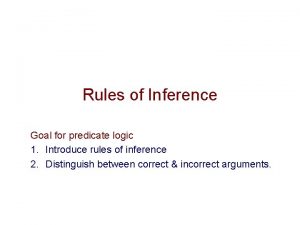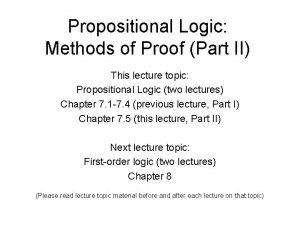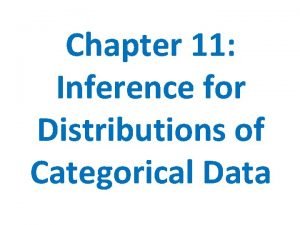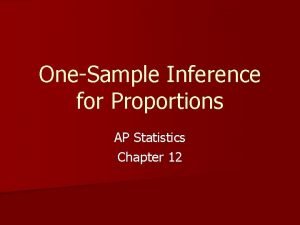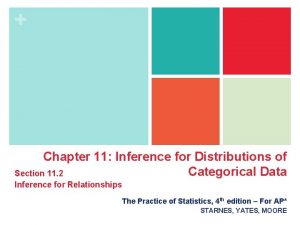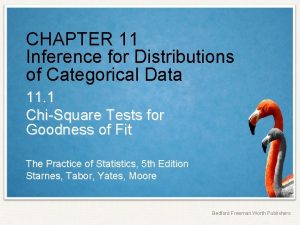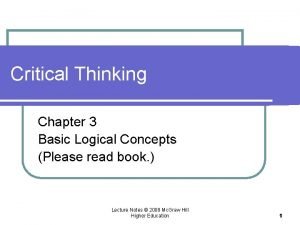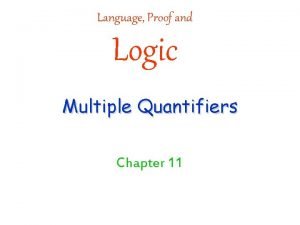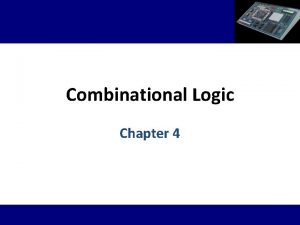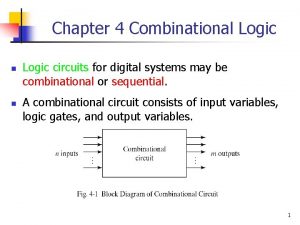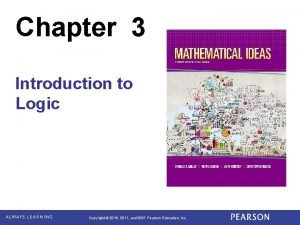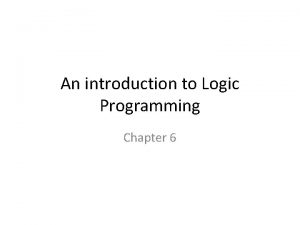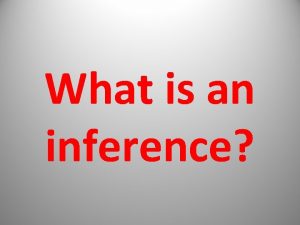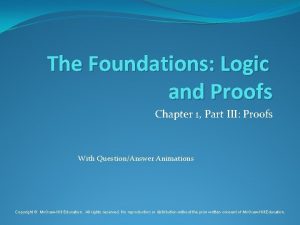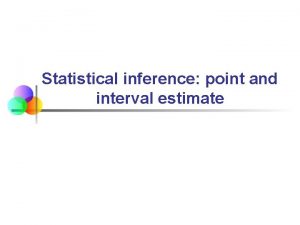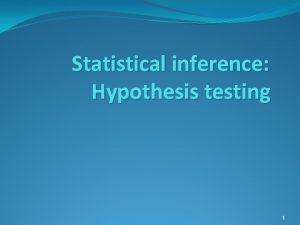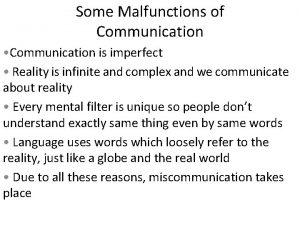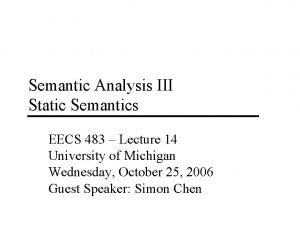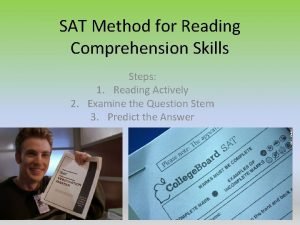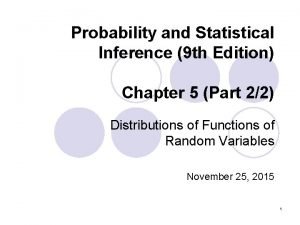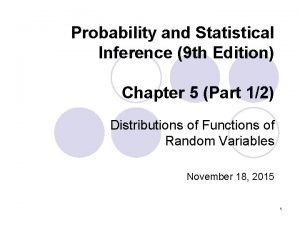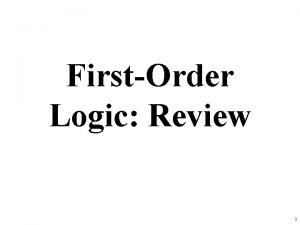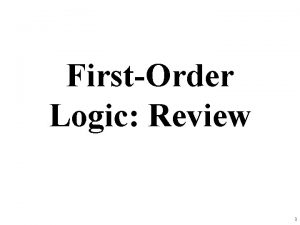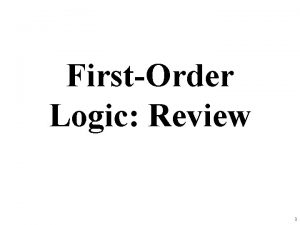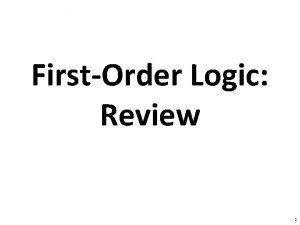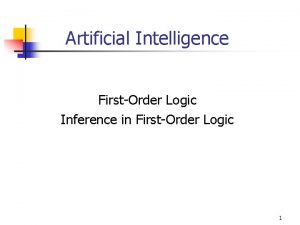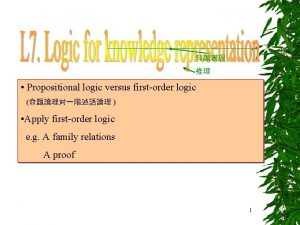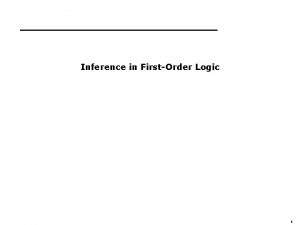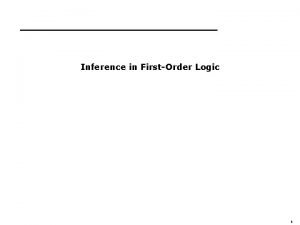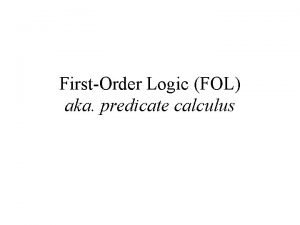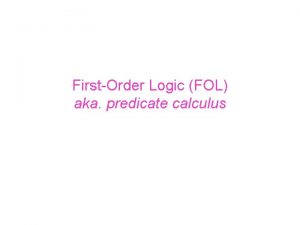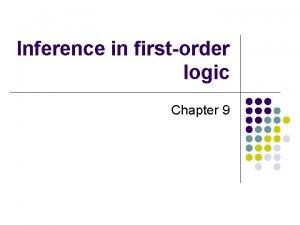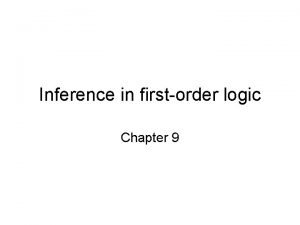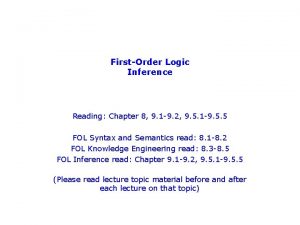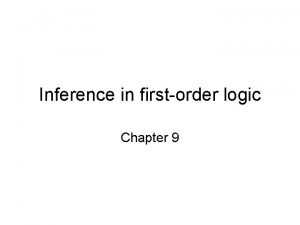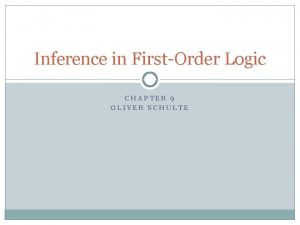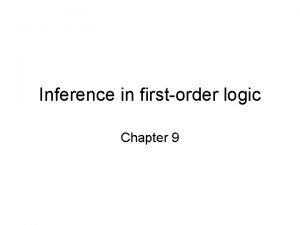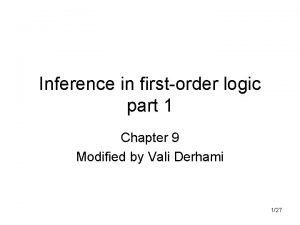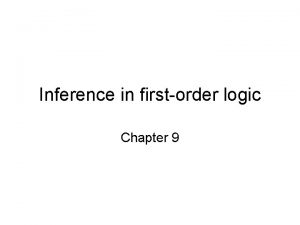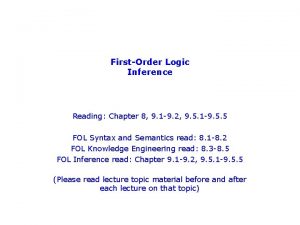Chapter 8 Inference in firstorder logic Inference in






































- Slides: 38

Chapter 8 Inference in first-order logic Inference in FOL, removing the quantifiers l i. e. , converting KB to PL l then use Propositional inference l l which is easy to do Inference rules for quantifiers l In KB, we have

A rule called Universal Instantiation (UI) substituting a ground term for the variable l SUBST( , ) denotes l l the result of applying the substitution to the sentence v SUBST({v/g}, ) l Here the examples are l {x / John}, {x / Richard}, {x / Father(John)}

Existential Instantiation: l For any sentence , variable v, and constant k that does not appear elsewhere in the KB: v SUBST({v/k}, ) x Crown(x) On. Head(x, John) If C 1 does not appear elsewhere in the KB l then we can infer: Crown(C 1) On. Head(C 1, John) l

Reduction to Propositional Inference Main idea l for existential quantifiers find a ground term to replace the variable l remove the quantifier l add this new sentence to the KB l l for universal quantifiers find all possible ground terms to replace the variable l add the set of new sentences to the KB l

apply UI to the first sentence from the vocabulary of the KB l {x / John}, {x / Richard} – two objects l we then obtain l view other facts as propositional variables l use inference to induce Evil(John)

Propositionalization The previous techniques applying this technique to every quantified sentence in the KB l we can obtain a KB consisting of propositional sentences only l however, this technique is very inefficient l in inference l it generates other useless sentences l

Unification and Lifting Unification a substitution θ such that applying on two sentences will make them look the same l e. g. , θ = {x / John} is a unification l applying on l it becomes l l and we can conclude the implication l using King(John) and Greedy(John)

Generalized Modus Ponens (GMP) The process capturing the previous steps A generalization of the Modus Ponens l also called the lifted version of M. P. For atomic sentences pi , pi', and q, there is a substitution such that l SUBST( , pi)= SUBST( , pi'), for all i: l

Generalized Modus Ponens

Unification UNIFY, a routine which takes two atomic sentences p and q l return a substitution l that would make p and q look the same l it returns fail if no such substitution exists l l Formally, UNIFY(p, q)= where SUBST( , p) = SUBST( , q) l is called the unifier of the two sentences l

Standardizing apart UNIFY failed on the last sentence in finding a unifier l reason? l two sentences use the same variable name l l l even they are having different meanings so, assign them with different names internally in the procedure of UNIFY l = standardizing apart l

MGU Most Generalized Unifier there may be many unifiers for two sentences l which one is the best? l the one with less constraints l e. g. , UNIFY(Knows(John, x), Knows(y, z)) l one unifier = { y/John, x/John, z/John } l another = {y/John, z/x} – the best l l even if z and x are not yet found

Forward and backward chaining Forward chaining start with the sentences in KB l generate new conclusions that l l l in turn allow more inferences to be made usually used when a new fact is added to the KB l and we want to generate its consequences l

First-order Definite clauses l the normal form of sentences for FC can contain variables l either atomic or l an implication whose l l antecedent is a conjunction of positive literals consequent a single positive literal Not every KB can be converted into a set of definite clauses, but many can l why? the restriction on single-positive-literal

Example We will prove that West is a Criminal First step translate these facts as first-order definite clauses l next figure shows the details l


For forward chaining, we will have two iterations

The above is the proof tree generated No new inferences can be made at this point using the current KB l such a KB is called a fixed point of the inference process

Backward chaining start with something we want to prove l (goal/query) find implication sentences l that would allow to conclude attempt to establish their premises in turn normally used l when there is a goal to prove (query)

Backward-chaining algorithm This is better to illustrate with a proof tree

One remark l backward chaining algorithm uses composition of substitutions l SUBST(COMPOSE(θ 1, θ 2), p) l l l = SUBST(θ 2, SUBST(θ 1, p)) it’s used because different unification are found for different goals l we have to combine them. l

Resolution Modus Ponens rule can only allow us to derive atomic conclusions l {A, A=>B}├ B l However, it is more natural to allow us derive new implication l {A => B, B => C} ├ A=>C, the transitivity l a more powerful tool: resolution rule l

CNF for FOL Conjunctive Normal Form l a conjunction (AND) of clauses each of them is a disjunction (OR) of literals l the literals can contain variables l l e. g. ,

Conversion to CNF l 6 steps

Skolemize process of removing l i. e. , translate x P(x) into P(A), A is a new constant l If we apply this rule in our sample, we have l which is completely wrong l since A is a certain animal l To overcome it, we use a function to represent any animal, these functions = Skolem functions l

Drop universal quantifiers l all variables now are assumed to be universally quantified Fortunately, all the above steps can be automated

Resolution inference rule

Example proof Resolution proves that KB |= by proving KB α unsatisfiable, i. e. , empty clause l First convert the sentences into CNF l next figure, empty clause l so, we include the negated goal Criminal(West) l


Example proof This example involves skolemization l non-definite clauses l hence making inference more complex l Informal description


The following answers: Did Curiosity kill the cat? First assume Curiosity didn’t kill the cat. Add it into KB Empty clause, so the assumption is false

Resolution strategies Resolution is effective but inefficient l because it is like forward chaining l the reasoning is randomly tried l There are four general guidelines in applying resolution

Unit preference When using resolution on two sentences l one of the sentences must be a unit clause l (P, Q, R, etc. ) The idea is to produce a shorter sentence: l e. g. , P Q => R and P l will produce Q => R l hence reduce the complexity of the clauses l

Set of support Identifying a subset of sentences from the KB l Every resolution combines a sentence l from the subset l and another sentence from the KB l l The resolvent (conclusion) of the resolution is added to the subset l and continue the resolution process l l How to choose this set? l a common approach: the negated query l l l to prove the query, assume negative and prove the contradiction advantage: goal-directed

Input resolution l Every resolution combines l one of the input sentences (facts) l l from the query or the KB with some other sentence Next fig

l. For each resolution, lat least one of the sentences from the query or KB

Subsumption (inclusion, 包含) l eliminates all sentences l that are subsumed by (i. e. , more specific than) an existing sentence in the KB l If P(x) is in KB, x means all arguments l then we don’t need to store the specific instances of P(x): P(A), P(B), P(C) …, l Subsumption helps keep the KB small
 Predicate logic rules of inference
Predicate logic rules of inference Inference in first order logic
Inference in first order logic What is inference in logic
What is inference in logic First order logic vs propositional logic
First order logic vs propositional logic First order logic vs propositional logic
First order logic vs propositional logic Third order logic
Third order logic Combinational vs sequential logic
Combinational vs sequential logic Tw
Tw Project management plan example
Project management plan example Is it x y or y x
Is it x y or y x Combinational logic sequential logic 차이
Combinational logic sequential logic 차이 If x = 0 and y = 1, which output line is enabled?
If x = 0 and y = 1, which output line is enabled? Chapter 11 inference for distributions of categorical data
Chapter 11 inference for distributions of categorical data Chapter 12 inference for proportions answers
Chapter 12 inference for proportions answers Chapter 11 inference for distributions of categorical data
Chapter 11 inference for distributions of categorical data Chapter 11 inference for distributions of categorical data
Chapter 11 inference for distributions of categorical data Logic and critical thinking chapter 2
Logic and critical thinking chapter 2 Critical thinking chapter 3
Critical thinking chapter 3 Logic chapter 3
Logic chapter 3 Language proof and logic solutions chapter 11
Language proof and logic solutions chapter 11 Logic chapter four
Logic chapter four For a three variable combinational circuits, m(1,4,7)=
For a three variable combinational circuits, m(1,4,7)= Logic chapter 3
Logic chapter 3 Logic chapter 6
Logic chapter 6 What is a infrence
What is a infrence What does infer
What does infer Inference iggy
Inference iggy Pictures for observation and inference
Pictures for observation and inference Rules of inference
Rules of inference Inference point
Inference point P value significant difference
P value significant difference Fact-inference confusion
Fact-inference confusion Static semantic analysis
Static semantic analysis Sat format
Sat format Difference between conclusion and inference
Difference between conclusion and inference What is inference in reading
What is inference in reading Proof of chebyshev's inequality
Proof of chebyshev's inequality Probability and statistical inference 9th solution pdf
Probability and statistical inference 9th solution pdf Difference between complete and incomplete circuit
Difference between complete and incomplete circuit
